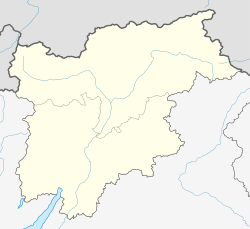Klausen (Austrian German: [ˈklaʊsn̩]; Italian: Chiusa [ˈkjuːza]; Ladin: Tluses or Tlüses) is an urban comune (municipality) and a village in South Tyrol in northern Italy, located about 20 kilometres (12 mi) northeast of the city of Bolzano. It is one of I Borghi più belli d'Italia ("The most beautiful villages of Italy").[3]
Klausen | |
|---|---|
| Gemeinde Klausen Comune di Chiusa Chemum de Tluses | |
 | |
| Coordinates: 46°38′N 11°34′E / 46.633°N 11.567°E | |
| Country | Italy |
| Region | Trentino-Alto Adige/Südtirol |
| Province | South Tyrol (BZ) |
| Frazioni | Gufidaun (Gudon), Latzfons (Lazfons), Verdings (Verdignes) |
| Government | |
| • Mayor | Peter Gasser |
| Area | |
• Total | 51.4 km2 (19.8 sq mi) |
| Elevation | 523 m (1,716 ft) |
| Population (Nov. 2010)[2] | |
• Total | 5,144 |
| • Density | 100/km2 (260/sq mi) |
| Demonym(s) | German:Klausner Italian: chiusani |
| Time zone | UTC+1 (CET) |
| • Summer (DST) | UTC+2 (CEST) |
| Postal code | 39043 |
| Dialing code | 0472 |
| Website | www |
Geography
editAs of 30 November 2010, it had a population of 5144 and an area of 51.4 square kilometres (19.8 sq mi).[4]
Klausen borders the following municipalities: Feldthurns, Lajen, Sarntal, Vahrn, Villanders and Villnöß.
Frazioni
editThe municipality of Klausen contains the frazioni (subdivisions, mainly villages and hamlets) Gufidaun (Gudon), Latzfons (Lazfons), and Verdings (Verdignes).
History
editKlausen is first mentioned in 1027, in a document issued by emperor Conrad II, as Clausa sub Sabiona sita, meaning chasm below the Säben Abbey.[5]
Coat-of-arms
editThe emblem represents an argent dexter key on gules. The emblem was used as a seal from 1448, known from 1397 and granted in 1540 by Cardinal Bernhard von Cles, Bishop of Brixen.[6]
Society
editLinguistic distribution
editAccording to the 2011 census, 91.30% of the population speak German, 7.88% Italian and 0.81% Ladin as first language.[7]
Demographic evolution
edit| Year | Pop. | ±% p.a. |
|---|---|---|
| 1921 | 2,588 | — |
| 1931 | 3,218 | +2.20% |
| 1936 | 3,107 | −0.70% |
| 1951 | 3,344 | +0.49% |
| 1961 | 3,632 | +0.83% |
| 1971 | 3,958 | +0.86% |
| 1981 | 4,098 | +0.35% |
| 1991 | 4,284 | +0.44% |
| 2001 | 4,613 | +0.74% |
Twin / associated cities
editReferences
edit- ^ "Superficie di Comuni Province e Regioni italiane al 9 ottobre 2011". Italian National Institute of Statistics. Retrieved 16 March 2019.
- ^ "Popolazione Residente al 1° Gennaio 2018". Italian National Institute of Statistics. Retrieved 16 March 2019.
- ^ "Trentino Alto Adige" (in Italian). Retrieved 31 July 2023.
- ^ All demographics and other statistics: Italian statistical institute Istat.
- ^ Martin Bitschnau; Hannes Obermair (2009). Tiroler Urkundenbuch, II. Abteilung: Die Urkunden zur Geschichte des Inn-, Eisack- und Pustertals. Vol. 1: Bis zum Jahr 1140. Innsbruck: Universitätsverlag Wagner. pp. 171–2 no. 199. ISBN 978-3-7030-0469-8.
- ^ Heraldry of the World: Klausen
- ^ "Volkszählung 2011/Censimento della popolazione 2011". Astat Info (38). Provincial Statistics Institute of the Autonomous Province of South Tyrol: 6–7. June 2012. Retrieved 2012-06-14.
- ^ Nürnberg International - Informationen zu den Auslandsbeziehungen der Stadt Nürnberg
- ^ "Planegg und seine Partner - Gemeinde Planegg".
External links
edit- Media related to Klausen at Wikimedia Commons
- (in German and Italian) Homepage of the municipality



